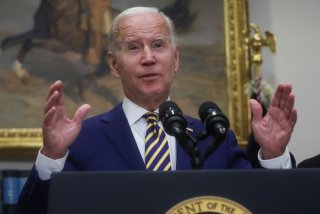Applications for Biden’s Student Loan Forgiveness Program Soar
“Today marks a big step, among others, that my administration is taking to make education a ticket to the middle class that folks can actually afford,” the president said.
The White House on Monday said that more than eight million Americans have already applied for the Biden administration’s sweeping student loan forgiveness program, according to a Politico report.
After an online application soft launch that began last Friday, President Joe Biden announced that he was officially launching the new application website, which was tested thoroughly over the weekend. The testing phase allowed for applications to be submitted, but they were not processed until the formal launch.
“Today marks a big step, among others, that my administration is taking to make education a ticket to the middle class that folks can actually afford,” the president said.
“The new student loan application is now open. If you have federal student debt, please visit StudentAid.gov. It’s easy, simple and fast and it’s a new day for millions of Americans all across our nation,” he continued.
Biden added that the application website “landed and handled more than eight million applications without a glitch or any difficulty.” He also urged other Americans saddled with federal student loan debt to apply via an online form that is “easy, simple and fast.”
According to the Education Department, more than forty million Americans are eligible for the debt relief program and roughly 81 percent of them are expected to apply for relief.
Under the student-loan relief plan, which was unveiled in August, those with federal student loans who make under $125,000 annually, or couples earning less than $250,000, qualify for up to $10,000 in forgiveness. But if a borrower received a Pell Grant to attend college, they could potentially get up to $20,000 in relief. Approximately 60 percent of all federal student loan borrowers received Pell Grants, which have a maximum allowance of $6,895 per academic year, according to the White House.
Furthermore, the student loan announcement extended the moratorium on repayments till January and created a new income-driven repayment (IDR) plan, designed to assist people who have a difficult time making large monthly payments. This will allow borrowers to pay no more than 5 percent of their monthly income on undergraduate loans, a sizable decrease from the current 10 percent threshold. The plan will also increase the amount of income that is considered non-discretionary, providing even more assistance to the average borrower.
Since the student loan announcement, the White House updated the program to exclude borrowers with privately held federal student loans. The policy change is centered on those who initially took out both Perkins and Federal Family Education Loans (FFEL), which were issued and managed by private banks but guaranteed by the federal government. More than four million borrowers have these commercially held loans, and roughly 770,000 people will be affected by the change, according to the White House.
Ethen Kim Lieser is a Washington state-based Finance and Tech Editor who has held posts at Google, The Korea Herald, Lincoln Journal Star, AsianWeek, and Arirang TV. Follow or contact him on LinkedIn.
Image: Reuters.

